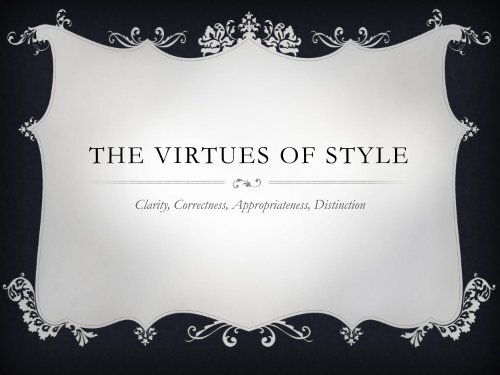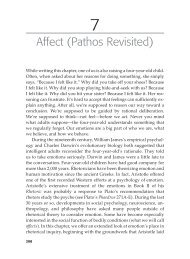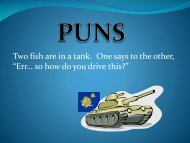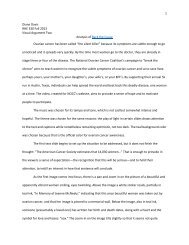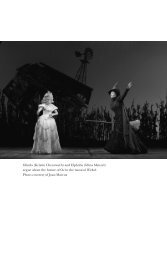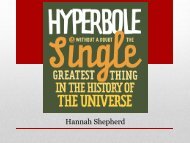THE VIRTUES OF STYLE
Elements of Style - DWRL Instructor Web Pages
Elements of Style - DWRL Instructor Web Pages
- No tags were found...
Create successful ePaper yourself
Turn your PDF publications into a flip-book with our unique Google optimized e-Paper software.
<strong>THE</strong> <strong>VIRTUES</strong> <strong>OF</strong> <strong>STYLE</strong><br />
Clarity, Correctness, Appropriateness, Distinction
CLARITY<br />
The rhetor speaks or writes in a way that the audience understands.<br />
Clarity involves the use of direct, vivid, precise, and familiar<br />
language that avoids clumsy sentence structure and unnecessary<br />
padding and abstraction.
CLARITY<br />
A rhetorical artifact can be<br />
It may or may not require<br />
what is called “plain style.”<br />
both ornate and clear; it can also<br />
be both plain and unclear, and<br />
both grammatically correct and<br />
unclear.
CORRECTNESS<br />
The rhetor uses standard written or spoken English, perhaps<br />
adding an occasional colloquial expression but avoiding grammatical<br />
errors, typos, and other ethos-busting issues.<br />
Errors make the rhetor seem poorly educated and unsophisticated,<br />
which makes it difficult to accept him or her as an authority on<br />
anything.
APPROPRIATENESS<br />
The rhetor uses clear and correct language that is appropriate to<br />
the situation.<br />
Using formal language in an informal setting is usually as<br />
inappropriate as using informal language in a formal setting.
APPROPRIATENESS<br />
Imagine showing up in black tie and tails or a stunning cocktail<br />
dress when everyone else is wearing jeans and flip flops;<br />
Or showing up wearing jeans and flip flops when everyone else is<br />
wearing formal attire.
DISTINCTION<br />
A rhetor uses language in a way that distinguishes his or her<br />
individual voice, speaking or writing in a way that is memorable,<br />
speaking or writing in a way that demonstrating wittiness, charm,<br />
sophistication, emphasis, or beauty.<br />
Distinction is the “special effects” or even “special affects” category<br />
of style.
RHETORICAL FIGURES<br />
Figures of Speech / Figures of Thought
FIGURES <strong>OF</strong> SPEECH<br />
Manipulations of language—alterations of meaning or form.<br />
There are two types of figures of speech: tropes and schemes.
COMPARISON<br />
Trope<br />
an artful deviation, literally a<br />
“turn,” from the normal use of a<br />
word or phrase to a non-literal<br />
one: a substitution of meaning<br />
from one word or phrase to<br />
another<br />
Scheme<br />
a notable arrangement of<br />
linguistic form. There are<br />
schemes of parallelism and<br />
schemes of accumulation, for<br />
example
TROPES<br />
Metaphor<br />
Simile<br />
Allegory<br />
Metonymy<br />
Synecdoche<br />
Catachresis<br />
Irony<br />
Litotes<br />
Hyperbole<br />
Pun<br />
Periphrasis<br />
Enallage
SCHEMES <strong>OF</strong> PARALLELISM<br />
Analphora (repetition of<br />
beginnings)<br />
Homoioteleuton (repetition of<br />
endings)<br />
Isocolon (repetition of equivalent<br />
phrase or clause structure)<br />
Chiasmus (crossover parallelism)<br />
Anadiplosis (repetition of<br />
endings as beginnings)<br />
Zeugma (yoking together of<br />
parallel elements with a common<br />
word)<br />
Polyptoton (repetition of same<br />
word in different forms)
SCHEMES <strong>OF</strong> ACCUMULATION<br />
Climax (reiterations in<br />
ascending order or importance)<br />
Antithesis (repetition of an<br />
idea by restating it in opposite<br />
terms)<br />
Analogy (repetition and<br />
enhancement of an idea by<br />
restating it in comparative terms)<br />
Enumeration (restating and<br />
amplifying an idea by dividing it<br />
into parts)<br />
Correctio (repeating an idea by<br />
revising or correcting what has just<br />
been said)
FIGURES <strong>OF</strong> THOUGHT<br />
Gestures or poses that dramatize the speaker’s thought process or attitude.
FIGURES <strong>OF</strong> THOUGHT<br />
Apostrophe (interruption of an<br />
ongoing discourse to deliver an<br />
aside to oneself, a god, or some<br />
other audience)<br />
Prosopopoeia (adopting the<br />
voice of some absent character as<br />
if they were there speaking)<br />
Dialogism (adopting both<br />
voices in a dialogue)<br />
Enthymeme (gesture of<br />
summing up a passage and capping<br />
it with a pithy conclusion the<br />
audience should draw from it)
FIGURES <strong>OF</strong> THOUGHT<br />
Sententia (declaration of an idea as<br />
if it were a deep wisdom or<br />
fundamental truth)<br />
Erotema (making an assertion in<br />
the form of a question with an obvious<br />
answer)<br />
Paradox (statement of an idea that<br />
appears false but when understood<br />
another way asserts a deeper truth)<br />
Praeteritio (mentioning something<br />
by saying you won’t discuss it)<br />
Aporia (talking about being unable<br />
to adequately talk about something)<br />
Aposiopesis (breaking off midspeech<br />
as if unable to continue)<br />
Praecisio (eloquent silence or<br />
extreme brevity)


